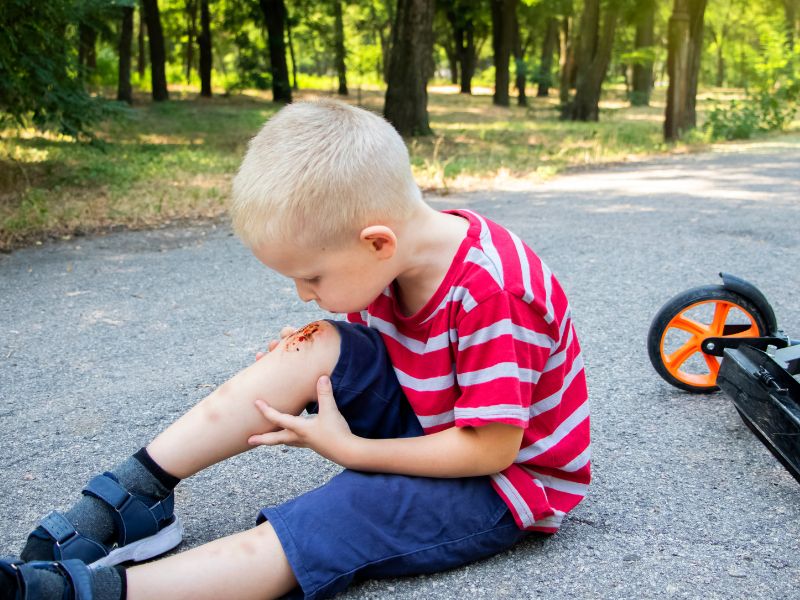Does My Child’s Cut Need Stitches? A Parent’s Quick Reference Guide

We’ve all been there: one minute your child is happily playing, and the next minute you’re staring at a cut wondering, “Is this a band-aid situation or a trip to urgent care?”
From sidewalk stumbles to backyard adventures gone wild, childhood comes with its fair share of bumps, bruises, and sometimes bloody surprises. The good news is, you don’t need a medical degree to spot a stitch-utation. Here’s your parent-friendly guide to knowing when a cut might need stitches, glue, or professional care.
The Stitch-uation: Signs It’s More Than a Minor Cut
- It’s deeper than 0.25 inches.
If you can see fat (yellowish tissue) or muscle (reddish tissue), it’s definitely time for professional help. A good rule of thumb: if you can’t press the skin edges together, get it checked. - It’s longer than half an inch.
Size matters when it comes to stitches. A long laceration, especially if it’s jagged or has torn edges, deserves a second look. - It’s in a high-risk spot.
Some body parts are simply more high-maintenance than others when it comes to cuts. These areas typically need professional attention:
- Face and Head: Cuts here heal better with stitches to minimize scarring. Plus, facial wounds can be deeper than they appear due to the thin skin.
- Hands and Fingers: These hardworking appendages need precise healing to maintain full function. Deep cuts can damage tendons, nerves, or blood vessels.
- Feet and Ankles: Weight-bearing areas experience constant movement and pressure, making proper closure crucial for healing.
- Joints: Cuts over knees, elbows, or knuckles often require stitches since the skin stretches and moves frequently.
Red Flags That Can’t Wait
Some situations require immediate medical attention, no questions asked:
- Heavy bleeding that doesn’t stop after 10-15 minutes of direct pressure
- Signs of infection: increasing redness, warmth, swelling, pus, or red streaking
- Numbness or inability to move the injured area normally
- Embedded objects (never remove them yourself!)
- Animal or human bites (these carry high infection risk)
- Very dirty wounds that can’t be thoroughly cleaned
The Golden Timeline
Here’s a crucial point many parents don’t know: stitches are most effective when placed within 6-12 hours of injury. After 24 hours, the risk of infection increases significantly, and stitches may no longer be an option.
Trust Your Parental Instincts
When you’re unsure, it’s always better to err on the side of caution. A quick evaluation at Urgent Care of Fairhope can provide peace of mind and ensure your little one heals properly. We’d rather see you for a cut that ends up needing just a good cleaning than miss a wound that needed attention.
Remember, you know your child best. If something feels “off” about how a cut looks or heals, don’t hesitate to seek professional advice. After all, when it comes to your child’s health, there’s no such thing as being too careful!
Search our Blog
Recent Posts
Urgent Care of Fairhope Named Best Urgent Care Clinic in Alabama
When you need medical care fast, you want to know you're choosing a provider you can trust. Recently, our community made that choice clear: Urgent Care of Fairhope was named a 2025 Best of [...]
Jingle Bells on The Bay: Fairhope Holiday Festivities 2025
Ho-ho-hold your reindeer! As we deck the halls and jingle all the way down the pier, get ready to unwrap a festive season like no other. Right here on the Eastern Shore, we’re mixing Southern [...]
Are Sugar Rushes Real? What Parents Need to Know
It’s a familiar scene for parents everywhere: the birthday cake gets sliced, the candy wrappers start flying, and within minutes the room erupts into chaos as kids start bouncing off the walls. Cue the collective [...]
World Menopause Month: What Women Need to Know
Menopause is a fact of life for all women, but it’s far from one-size-fits-all. Some women experience it earlier or later than others, symptoms can range from barely noticeable to highly disruptive, and individual health [...]
Fairhope’s Spook-tacular Guide to Halloween Happenings 2025
Boo-tiful Fairhope and Eastern Shore residents, gather ’round for a spine-tingling treat! It’s that time of year when things go bump in the night, and Urgent Care of Fairhope is here to ensure you don’t [...]
Your Ultimate Back-to-School Health Cheat Sheet
Sharpen those pencils and pack the lunchboxes, because back-to-school season is officially here. Between new teachers, early mornings, and the scramble to find missing sneakers, parents have plenty on their plates. That’s why we’ve pulled [...]


